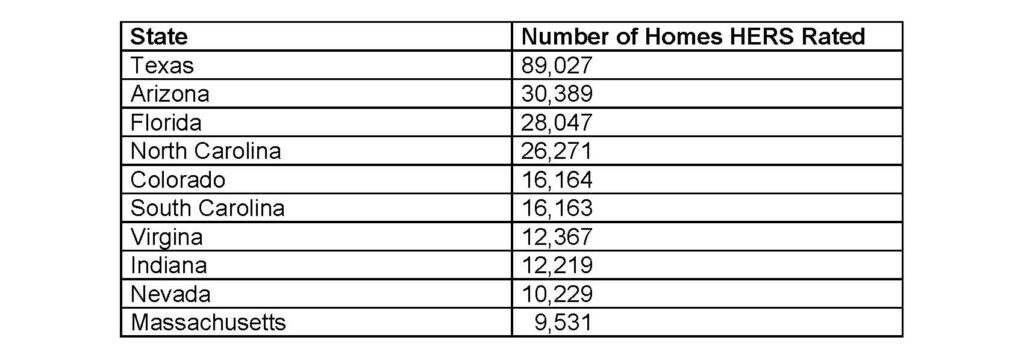Residential Energy Services Network (RESNET) has released data on the number of Home Energy Ratings Score (HERS)-rated homes in 2023. More than 360,000 homes were HERS rated last year, an increase of more than 22,000 homes compared to 2022. This accounts for 28 percent of all new homes built last year. The cumulative number of HERS-rated homes in the U.S. now tops 3.9 million, a stunning figure when you consider that just two years ago, the number of HERS homes reached 3 million.
10 States Leading in HERS-Rated Homes
Virtually every state in the union has seen its number of HERS homes increase in recent years. Not surprisingly, Texas leads the nation in the number of HERS-rated homes, and the other top 9 states are as follows:

Along with new data on the total number of HERS-scored homes, RESNET released a breakdown of the average HERS Index Score by state, which shows that the average HERS index score is lowest in California at 21, though the state had a smaller number of HERS-scored homes at 3,222.
RESNET notes that of greater significance is the energy bill savings achieved by families who will purchase these homes. By its calculations, HERS-rated homes built in 2023 will net more than $296M in annual energy savings compared to a standard reference home and help reduce carbon dioxide emissions by more than 1.6 million tons annually. According to the U.S. Environmental Protection Agency (EPA) calculator, the reduction in carbon emissions this year alone is the equivalent of removing more than 325,000 passenger vehicles from U.S. roadways.
“Homeowners are increasingly seeing energy efficiency as a major selling point of buying a new home,” said RESNET Executive Director Steve Baden. “To take advantage of this opportunity, builders across the nation are presenting their homes’ energy performance in a way that every home buyer can understand, the home’s HERS Score. I expect this trend will continue. It is particularly encouraging that the average HERS Index Score of homes that were HERS-rated was 57. That’s 43% more efficient than homes built as recently as 2006 and 73% more efficient than a typical home built in the 1970s.”
Regarding any future increase in HERS-scored homes, Baden stated, “RESNET is not content with the current market share of homes that are HERS-rated. In 2023, the RESNET Board of Directors adopted the goal of RESNET having a million ratings a year by the end of 2028.”
Why It Matters
According to new research released this week from the Rhodium Group, in 2023, U.S. greenhouse gas emissions were down 1.9 percent year-on-year, even as the economy expanded by 2.4 percent over the period. Those emissions remained below pre-pandemic levels and dropped 17.2 percent below 2005 levels. The U.S. buildings sector saw a 4 percent decline in GHG emissions last year. This is progress, however, overall GHG emission reductions would have to more than triple the 1.9 percent total reduction every year from 2024 through 2030 to meet the U.S. climate goal under the Paris Agreement.
RESNET’s aggressive goals for increasing the number of energy-efficient, HERS-rated homes will certainly help cut emissions even further as the rate of adoption increases nationwide. The nearly 4 million HERS-scored homes built to date have saved 74 million tons of GHG emissions, the equivalent of removing 15 million passenger cars from the roadways.
